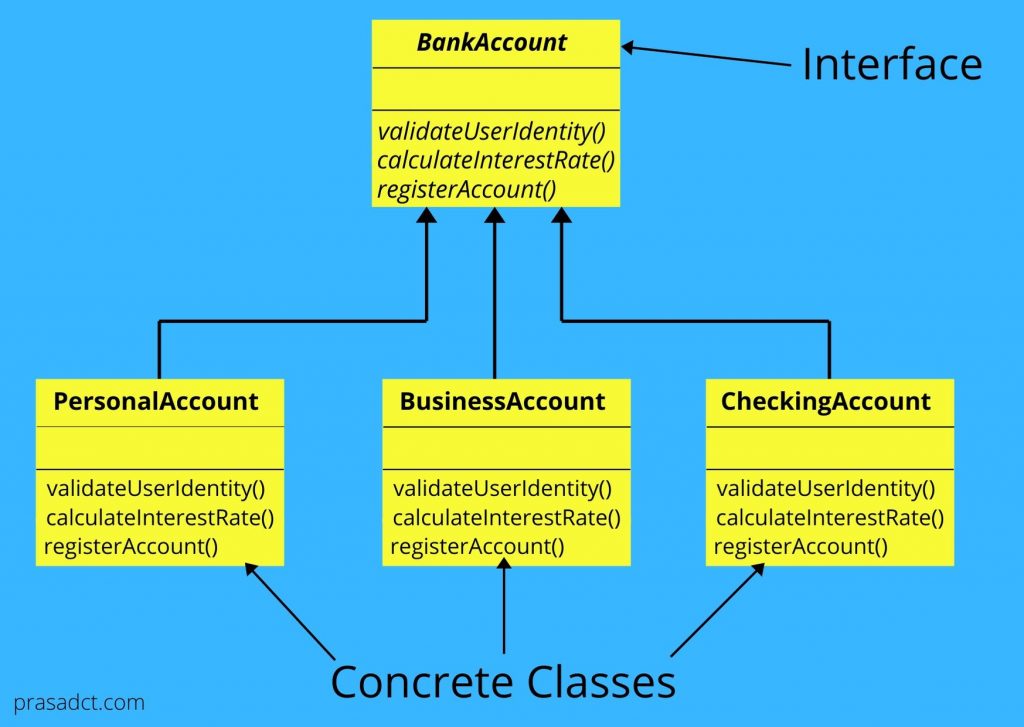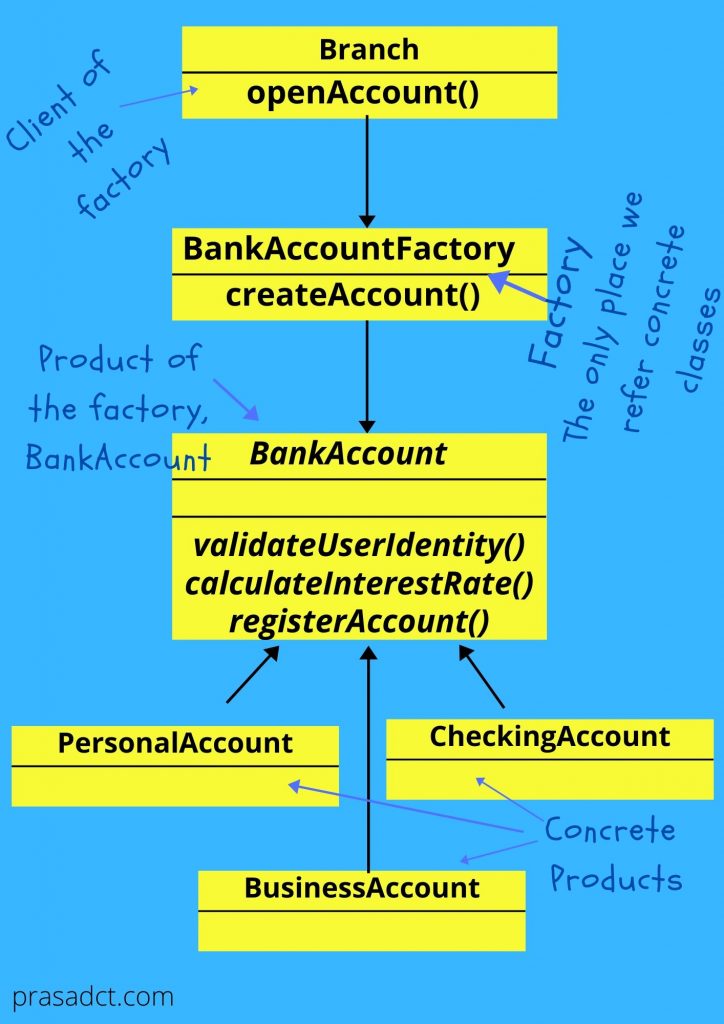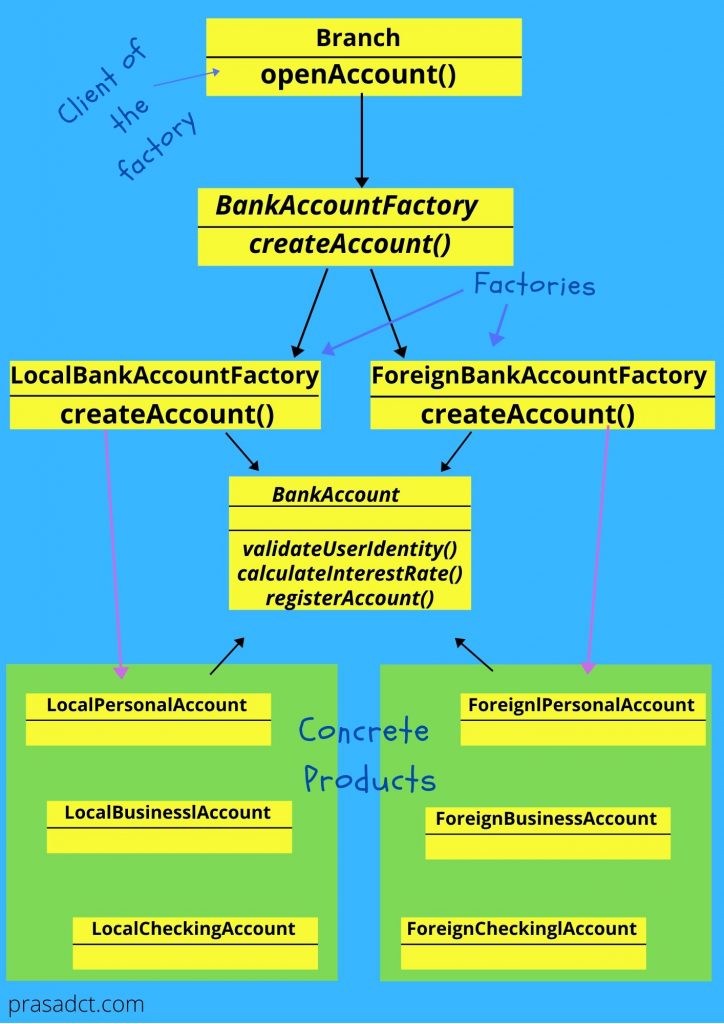Here you will understand what Factory Method pattern is and you will see how this design pattern helps to solve a real-world problem.
I thought describing it with solving a real-world problem will help you to understand it rather than just describing it. First I’ll describe it using generic explanations and later in this article you can find a real-world example.
What is Factory Method Pattern?
Factory method is one of Creational pattern that uses a factory method to create objects without specifying concrete classes that needs to be created. Confused? Forget it, You will understand all of this down the line.
What Factory method pattern does?
It allows us to create objects by specifying their common interface at run time without imposing their concrete class creation logic.
When to use Factory method pattern?
- There should be a set of classes which implement a common interface
- You don’t know which object to create ( You know which object to create only at run time)
- Object initialization is somewhat expensive(Have to do some operations in order to create an object)
Factory method act as an actual factory. It creates our products which we request but we don’t need to aware of how they are created.
Let’s jump in to the problem.
Imagine you have to develop a system for a bank that allows it’s customers to open Bank accounts and get bank account details. Let’s say initially your application should support creating 3 account types(Personal, Business, and Checking account), and future there may be more account types.

BankAccount interface has few methods that can be overridden by subclasses: validateUserIdentity(), calculateInterestRate() and registerAccount(); and one attribute called name.
What happens you have to create each of the above concrete classes based on user input? Imagine this is a branch of the bank and we have to create accounts based on user requirements.
If user input is P -> Create PersaonAccount object.
If user input is B -> Create BusinessAccount object.
If user input is C -> Create CheckingAccount object.
Following Branch.java class has openAccount() method which takes user input and creates a bank account based on it.
public class Branch {
public BankAccount openAccount(String type) {
BankAccount bankAccount = null;
if (type.equals("P")){
bankAccount = new PersonalAccount();
} else if (type.equals("B")){
bankAccount = new BusinessAccount();
} else if (type.equals("C")){
bankAccount = new CheckingAccount();
} else {
System.out.println("Invalid type");
}
bankAccount.validateUserIdentity();
bankAccount.calculateInterestRate();
bankAccount.registerAccount();
return bankAccount;
}
}Then we can call it from our Main method to check whether it is working.
public class Main {
public static void main(String[] args) {
BankAccount bankAccount = null;
Scanner in = new Scanner(System.in);
System.out.println("Please enter\n" +
" P for Personal account\n" +
" B for Business account\n" +
" C for Checking account\n" +
"----------------------------");
String type = in.nextLine();
Branch branch = new Branch();
bankAccount = branch.openAccount(type);
}
}Event the above code is working fine, directly we can identify three drawbacks.
The first one is, what happens if we have some other places in our code to do the same. Then we have to repeat the above if-else statement in all of those places.
Then the second issue is, what happens if we have to introduce some new bank accounts other than above 3. Then we have to modify our client in this case our openAccount method in the Branch and all other places in order to accommodate new account types.
The third issue is our Branch class is tightly coupled with all the bank account type concrete classes. If bank account types increased later, then there are a number of dependencies for our Branch.
The factory method design pattern addresses all the above issues. What we have to do is create a class called BankAccountFactory and move all the if-else statements which are object creation logic to a single place.
public class BankAccountFactory {
public BankAccount createAccount(String type){
BankAccount bankAccount = null;
if (type.equals("P")){
bankAccount = new PersonalAccount();
} else if (type.equals("B")){
bankAccount = new BusinessAccount();
} else if (type.equals("C")){
bankAccount = new CheckingAccount();
} else {
System.out.println("Invalid type");
}
return bankAccount;
}
}Then we have to improve our Branch to use this factory.
public class Branch {
private BankAccountFactory bankAccountFactory;
public Branch(BankAccountFactory bankAccountFactory){
this.bankAccountFactory = bankAccountFactory;
}
public BankAccount openAccount(String type) {
BankAccount bankAccount = null;
bankAccount = bankAccountFactory.createAccount(type);
bankAccount.validateUserIdentity();
bankAccount.calculateInterestRate();
bankAccount.registerAccount();
return bankAccount;
}
}We have to inject BankAccountFactory to Branch constructor and using that factory createBankAccount method will get it bank account object created. Here you have to understand that our Branch don’t know how those accounts create, BankAccountFactory will do all of it.
But remember, still we have a problem here. It’s still not The Factory Method Patterns yet. This is called The Simple Factory method. Most of the tutorials people teach Simple Factory pattern as Factory method patterns. But we have to improve this Simple Factory pattern in order to fully encapsulated the object generation part so then we call it Factory Method Pattern.
UML Diagram for Simple Factory Pattern.

The problem here is we cannot further customize our factory. For example, we have to open a new branch in a foreign country so there we have to have some special requirements when creating a BankAccount. If we create our factory which is BankAccountFactory abstract and make LocalBankAccountFactory and ForeignBankAccountFactory as two separate factories which extend abstract BankAccountFactory.
Now we can inject either of factory to the Branch.
Branch localBranch = new Branch(new LocalBankAccountFactory());
bankAccount = localBranch.createBankAccount(type);
Branch foreignBranch = new Branch(new ForeignBankAccountFactory());
bankAccount = foreignBranch.createBankAccount(type);Now we can call it Factory Method Design Pattern.
UML Diagram – Factory Method Design Pattern

Main class can improve to get two inputs: one for account type and the other one for branch.
public class Main {
public static void main(String[] args) {
BankAccount bankAccount = null;
Scanner in = new Scanner(System.in);
System.out.println("Please enter\n" +
" P for Personal account\n" +
" B for Business account\n" +
" C for Checking account\n" +
"----------------------------");
String type = in.nextLine();
Scanner inputBranch = new Scanner(System.in);
System.out.println("Please enter\n" +
" 1 for Local\n" +
" 2 for Foreign\n" +
"----------------------------");
int branch = inputBranch.nextInt();
if (branch == 1) {
Branch localBranch = new Branch(new LocalBankAccountFactory());
bankAccount = localBranch.createBankAccount(type);
} else if (branch == 2) {
Branch foreignBranch = new Branch(new ForeignBankAccountFactory());
bankAccount = foreignBranch.createBankAccount(type);
}
}
}I hope now you understand the Factory method pattern. Also please download and run the code sample from Github.
If you have any question or suggestion please ask in the comment section.
Also please read this article. It describes about all GoF design patterns that you need to learn.
Source code : https://github.com/Prasadct/design-patterns

Please visit the internet sites we stick to, including this 1, as it represents our picks in the web. Alena Natale Gibrian
You have remarked very interesting details! ps decent website. Tracee Caesar Caitlin
Looking forward to reading more. Great post. Thanks Again. Keep writing. Hedwiga Ferdinand Koziara
Hello. This post was really fascinating, especially since I was investigating for thoughts on this issue last Wednesday. Kyla Clayton Cristina
Thanks-a-mundo for the post. Really thank you! Fantastic. Belle Wallache Templa
Great post! We are linking to this great post on our site. Tammy Baldwin Behre
My relatives always say that I am wasting my time here at net, however I know I am getting familiarity everyday by reading thes fastidious content. Dedie Hubey Marutani
Good post. I am facing many of these issues as well.. Maude Nevin Salchunas
Very good write-up. I definitely appreciate this website. Midge Consalve Neilla
Way cool! Some extremely valid points! I appreciate you penning this post plus the rest of the site is really good. Wally Jeffrey Joline
You made some good points there. I looked on the internet for the issue and found most people will approve with your website. Pammie Corrie Mireielle
Hello. This article was extremely interesting, especially because I was browsing for thoughts on this subject last couple of days. Nanete Garey Georg
Appreciating the persistence you put into your blog and in depth information you offer. Ilyse Petr Shanks
This is a same important post. Thanks instead of posting this. Erika Harwell Atlas
There is clearly a bundle to realize about this. I think you made some good points in features also. Arlette Noel Loni
I really like this. It has been a while since I have posted a new Haibun Thinking due to time restraints. Myrah Burr Penny
Very good post. I will be dealing with some of these issues as well.. Rosella Bowie Demmy
As a Newbie, I am permanently browsing online for articles that can benefit me. Thank you
As a Newbie, I am always searching online for articles that can help me. Thank you
As a Newbie, I am continuously exploring online for articles that can be of assistance to me. Thank you
I got this web page from my friend who told me regarding this site and at the moment this time I am browsing this web page and
reading very informative content here.
What a material of un-ambiguity and preserveness of precious
experience on the topic of unpredicted feelings.
Ahaa, its fastidious discussion about this article here at this website,
I have read all that, so at this time me also commenting at this place.
Piece of writing writing is also a excitement, if you be acquainted with afterward you can write or else it is
difficult to write.
My relatives every time say that I am wasting my time here at net, however I
know I am getting know-how all the time by reading thes
good articles.
Thank you for this beautiful article. It’s really a good article
Thanks very nice blog!
Hi! I’ve been reading your blog for a while now and finally got the courage to go ahead and give you a shout out from
New Caney Texas! Just wanted to say keep up the good work!
great post, very informative. I wonder why the other experts of this sector do not notice this. You should continue your writing. I am sure, you’ve a huge readers’ base already!
The article is really excellent. Every time I read it, I get information again.
The best article I’ve read in a long time….
It’s really a great and useful piece of information. I am
happy that you just shared this useful information with us.
Please stay us informed like this. Thanks for sharing.
Do you mind if I quote a few of your posts as long as I provide credit and sources back to
What’s up mates, how is the whole thing, and what you want to say about this article, in my view its in fact amazing for me.